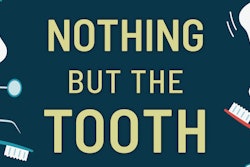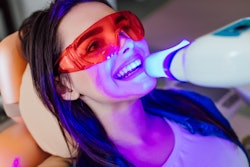
Stroll down the dental aisle at your local pharmacy or grocery store and you'll see a confusing array of products promising to whiten your teeth. The selection includes toothpastes, whitening strips, paint-on gels, mouth rinses, and even chewing gum. If you're struck by decision paralysis over which product to recommend, imagine how the patient feels.
Researchers performed a systematic review of over-the-counter (OTC) teeth whiteners in 2006 and concluded that all home bleaching products were effective compared to a placebo or no treatment. But only strips and gels were available at that time.
 Dr. Teresa Yang.
Dr. Teresa Yang.More recently, another group conducted its own review evaluating the effectiveness of OTC whiteners currently available to consumers (Brazilian Dental Journal, May-June 2020, Vol. 31:3, pp. 221-235). In total, the researchers looked at 24 studies, 22 of which were randomized clinical trials. They excluded dentist-prescribed, tray-based bleaching and OTC whitening chewing gums.
However, they encountered challenges in the review process primarily due to the lack of consistent research protocols. Color measuring instruments varied from objective to subjective. Conditions also differed; for example, some studies dried the teeth prior to assessing the shade and others did not.
Furthermore, manufacturers partially or totally funded a number of studies. Despite these concerns, the researchers were able to draw some conclusions.
Whitening toothpastes
Toothpastes now contain myriad ingredients claiming to whiten teeth. These include baking soda, papain, hydroxyapatite, calcium carbonate, sodium fluoride, peroxide, and tetrasodium pyrophosphate.
Of the 10 studies evaluated on this subject, three were of good quality. Based on the good-quality studies, the authors determined that toothpastes effectively remove extrinsic stains in comparison to a placebo. However, their effectiveness was inferior and not significant when compared to whitening strips.
Of note, two of the three good-quality studies looked at blue covarine as a whitening agent. However, blue covarine doesn't break down pigments or remove stains. Instead, it causes a color shift from yellow to blue and creates a whitening illusion.
Whitening strips
A total of seven studies reviewed whitening strips, and two good-quality studies determined that whitening strips were effective. One of those studies showed that a lower hydrogen peroxide concentration used for an extended time had better results than a higher-concentration strip applied for a shorter time.
Furthermore, several studies indicated that whitening strips were just as effective as carbamide peroxide trays. However, two of the studies used the carbamide peroxide trays in an abbreviated protocol of 30 minutes, twice a day.
Carbamide peroxide gels are slow-release -- half of the peroxide is released initially and the rest over two to six hours, allowing for better oxidation of the organic matrix. The abbreviated application times may not have given the carbamide peroxide its full potential.
Paint-on gels
Only two studies solely addressed the effectiveness of paint-on gels. Based on the limited evidence, it's difficult to conclude that such gels are effective. In comparative studies, whitening strips prove superior to gels. Unlike gels, the strips act as a barrier and a reservoir for the whitening agent.
Conclusions
Maybe the consumer already knows what the literature review concluded. At-home teeth whitening products are in high demand, according to a May 24 article from the Wall Street Journal.
Whitening strips showed superior effectiveness compared to all other OTC whitening products, the review showed. Meanwhile, whitening toothpastes strictly remove extrinsic stains but may provide a lower-cost method.
In general, strips are a comparable alternative to tray-based bleaching methods. Yet strips may be an inexpensive consumer option compared to custom-made trays. Overall, more independent, long-term randomized clinical studies need to be conducted in this area.
Dr. Teresa Yang started two practices from scratch and sold them both. She currently serves as a trustee at the California Dental Association and as the editor of WestViews, a publication of the Western Los Angeles Dental Society. Her general interest articles have been published in various literary journals. She can be reached at [email protected].
The comments and observations expressed herein do not necessarily reflect the opinions of DrBicuspid.com, nor should they be construed as an endorsement or admonishment of any particular idea, vendor, or organization.



















